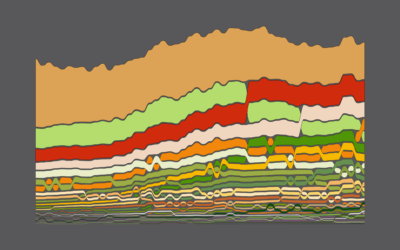Cuisine Ingredients
Every cuisine, while sharing many common elements with others, uses a handful of ingredients that combine for unique flavors.
With Chinese food, you often see soy sauce, green onion, and sesame oil. With Italian food, you often see garlic, parmesan cheese, and olive oil. Vietnamese food uses fish sauce. Korean food uses chili paste.

As I venture into new cooking territories, it’s been fun to discover the flavor bombs from various cuisines. A lot of “where have you been all of my life” moments.
So what are the ingredients that make each cuisine?
I looked into a Yummly ingredients dataset. It contains ingredient lists for a bit under 40,000 recipes from 20 cuisines. This amounted to 6,714 ingredients. Here are the five most used ingredients in each cuisine:
Most Used Ingredients

Brazilian
British
Cajun Creole
Chinese
Filipino
salt
salt
salt
soy sauce
salt
onions
all−purpose flour
onions
sesame oil
garlic
olive oil
butter
garlic
salt
onions
lime
milk
green bell pepper
corn starch
water
water
eggs
butter
sugar
soy sauce
0%
25%
50%
Indian
French
Greek
Irish
Italian
salt
salt
salt
salt
salt
sugar
olive oil
onions
all−purpose flour
olive oil
all−purpose flour
dried oregano
garam masala
butter
garlic cloves
unsalted butter
garlic cloves
water
onions
grated parmesan
olive oil
feta cheese crumbles
ground turmeric
potatoes
garlic
Korean
Jamaican
Japanese
Mexican
Moroccan
salt
soy sauce
soy sauce
salt
salt
onions
salt
sesame oil
onions
olive oil
water
mirin
garlic
ground cumin
ground cumin
garlic
sugar
green onions
garlic
onions
ground allspice
water
sugar
olive oil
garlic cloves
Spanish
Russian
Southern US
Thai
Vietnamese
salt
salt
salt
fish sauce
fish sauce
sugar
butter
olive oil
garlic
sugar
onions
all−purpose flour
garlic cloves
salt
salt
all−purpose flour
sugar
extra−virgin olive oil
coconut milk
garlic
sour cream
large eggs
onions
vegetable oil
water

Brazilian
British
Cajun Creole
salt
salt
salt
onions
all−purpose flour
onions
olive oil
butter
garlic
lime
milk
green bell pepper
water
eggs
butter
0%
25%
50%
French
Chinese
Filipino
soy sauce
salt
salt
sesame oil
garlic
sugar
all−purpose flour
salt
onions
unsalted butter
corn starch
water
sugar
soy sauce
olive oil
Indian
Greek
Irish
salt
salt
salt
olive oil
onions
all−purpose flour
dried oregano
garam masala
butter
garlic cloves
water
onions
feta crumbles
ground turmeric
potatoes
Jamaican
Japanese
Italian
salt
soy sauce
salt
onions
salt
olive oil
water
mirin
garlic cloves
garlic
sugar
grated parmesan
ground allspice
water
garlic
Korean
Mexican
Moroccan
soy sauce
salt
salt
sesame oil
onions
olive oil
garlic
ground cumin
ground cumin
green onions
garlic
onions
sugar
olive oil
garlic cloves
Spanish
Russian
Southern US
salt
salt
salt
sugar
butter
olive oil
onions
all−purpose flour
garlic cloves
all−purpose flour
sugar
e.v. olive oil
sour cream
large eggs
onions
Thai
Vietnamese
fish sauce
fish sauce
garlic
sugar
salt
salt
coconut milk
garlic
vegetable oil
water
It’s somewhat interesting. Soy sauce and fish sauce take the top spots in the Asian cuisines, whereas salt is the main seasoning ingredient elsewhere. You see oregano in Greek and garam masala in Indian.
However, overall, this view covers more general ingredients. Salt is used in a lot of cuisines. So is soy sauce. What ingredients are more specific to certain cuisines?
I calculated the relative usage of each ingredient for each cuisine. More specifically, I calculated the percentage of recipes that used an ingredient in a cuisine and divided it by the usage among all other cuisines. For example, in the results below, sweetened condensed milk showed about 22 times the usage in Brazilian recipes than the other cuisines.
Most Cuisine-Specific Ingredients

Brazilian
British
Cajun Creole
Chinese
Filipino
sw. cond. milk
milk
andouille sausage
hoisin sauce
cooking oil
coconut milk
heavy cream
creole seasoning
oyster sauce
bay leaves
lime
baking powder
cajun seasoning
sesame oil
oil
tomatoes
unsalted butter
celery ribs
corn starch
fish sauce
onions
flour
celery
peanut oil
soy sauce
0
20
0
4
0
120
0
40
0
12
Indian
French
Greek
Irish
Italian
shallots
feta cheese
garam masala
baking soda
grated parmesan
unsalted butter
feta cheese crumbles
ground turmeric
potatoes
fresh basil
large eggs
cucumber
cumin seed
buttermilk
e.v. olive oil
all−purpose flour
dried oregano
tumeric
baking powder
olive oil
butter
fresh lemon juice
green chilies
milk
grnd. black pepper
0
3
0
80
0
150
0
8
0
20
Korean
Jamaican
Japanese
Mexican
Moroccan
allspice
sake
Gochujang base
corn tortillas
couscous
ground allspice
mirin
kimchi
salsa
chickpeas
thyme
rice vinegar
toasted sesame seeds
flour tortillas
ground ginger
fresh thyme
soy sauce
sesame seeds
black beans
ground cinnamon
dried thyme
scallions
sesame oil
avocado
ground coriander
0
50
0
120
0
1,000
0
250
0
140
Spanish
Russian
Southern US
Thai
Vietnamese
beets
buttermilk
extra−virgin olive oil
lemongrass
fish sauce
fresh dill
baking soda
dry white wine
fish sauce
beansprouts
sour cream
baking powder
red bell pepper
coconut milk
lemongrass
potatoes
vanilla extract
fresh parsley
peanuts
cucumber
flour
milk
tomatoes
lime juice
rice vinegar
0
80
0
20
0
4
0
40
0
20

Brazilian
British
Cajun Creole
sw. cond. milk
milk
andouille ssg.
coconut milk
heavy cream
creole sng.
lime
baking powder
cajun sng.
tomatoes
unsalted butter
celery ribs
onions
flour
celery
0
20
0
4
0
120
French
Chinese
Filipino
shallots
hoisin sauce
cooking oil
unsalted butter
oyster sauce
bay leaves
large eggs
sesame oil
oil
all−purpose flr.
corn starch
fish sauce
butter
peanut oil
soy sauce
0
3
0
40
0
12
Indian
Greek
Irish
feta cheese
garam masala
baking soda
feta crumbles
ground turmeric
potatoes
cucumber
cumin seed
buttermilk
dried oregano
tumeric
baking powder
fresh lemon juice
green chilies
milk
0
80
0
150
0
8
Italian
Jamaican
Japanese
allspice
sake
grated parmesan
ground allspice
mirin
fresh basil
thyme
rice vinegar
e.v. olive oil
fresh thyme
soy sauce
olive oil
dried thyme
scallions
grnd. black pepper
0
50
0
120
0
20
Korean
Mexican
Moroccan
Gochujang base
corn tortillas
couscous
kimchi
salsa
chickpeas
tstd. sesame sds.
flour tortillas
ground ginger
sesame seeds
black beans
grnd. cinnamon
sesame oil
avocado
grnd. coriander
0
1,000
0
250
0
140
Russian
Southern US
Spanish
beets
buttermilk
e.v. olive oil
fresh dill
baking soda
dry white wine
sour cream
baking powder
red bell pepper
potatoes
vanilla extract
fresh parsley
flour
milk
tomatoes
0
80
0
20
0
4
Thai
Vietnamese
lemongrass
fish sauce
fish sauce
beansprouts
coconut milk
lemongrass
peanuts
cucumber
lime juice
rice vinegar
0
40
0
20
*Only ingredients that were in at least 10% of available recipes are shown.
Now we’re getting somewhere. The French recipes use relatively more shallots and butter; the Greek recipes use more feta cheese; the Moroccan recipes use more couscous.
Combine the two measurements, and you can quickly spot the ingredients that are both common and unique.
All in all, the data confirms my experiences with certain cuisines. For the ones I haven’t tried much of yet, it’s nice to see what I might be getting into later on. Filipino pork belly, here I come.
Notes
- As usual, I used R for analysis and data preparation. The bar plots were also made in R, edited in Illustrator, and then exported with ai2html. The interactive scatterplot was made using D3.js. I used a force-directed graph as a form of jitter to reduce overlapping.
- The cuisines and ingredients collections are limited by the dataset. Each observation only contained an ingredient list and the cuisine, so it’s hard to say what each category covers. Main dishes? Beverages? However, the recipe count hopefully reduced some of the possible noise.
Become a member. Support an independent site. Make great charts.
See What You Get






